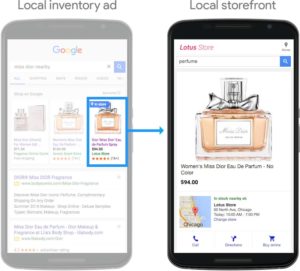The growth of e-commerce is somewhat overstated. The importance of connecting digital to brick-and-mortar stores, however, is important yet underemphasized. According to Google data, 90% of purchases still happen in a retail environment and over 85% of all retail purchases are researched online. 76% of people who conduct a local search on their phone visit a business within 24 hours and 28% of those searches result in a purchase. This means having an online presence that highlights your product mix, and whether the consumer can purchase that product at your store, is paramount to driving retail success. Consumers are researching online first and if they can find the product locally, this gives your business a much better chance to win. Enter Local Inventory Ads.
What are Local Inventory Ads?
Local Inventory Ads apply to businesses who have at least one local storefront. These are digital ads that display the products that you have in stock at your local storefront. Think of it as a virtual window into your store.
When people near your store search for the products you have, wouldn’t it be nice to show up in front of those people in those moments? That’s what Local Inventory Ads enable you to do.
What Do Local Inventory Ads Look Like?
Local Inventory Ads are a type of Google Shopping ad. In addition to having the typical product image, title, price, and other information that normally shows up in a Google Shopping ad, Local Inventory Ads have an “In Store” icon that displays in the corner of the ad. This helps users understand that the product they’re looking for is available in a store near them.
When someone clicks on a Local Inventory Ad an online “local storefront” opens and displays store information such as address, phone number, email, and hours. There are buttons that appear to easily get directions, call, or go to the business’s website.
Why Are Local Inventory Ads Important?
If you are a business who has at least one local storefront, Local Inventory Ads are a great way to get ahead of the curve, as well as provide your consumers with both an online and retail shopping experience. They add something unique that your competitors may not be doing and based on the proximity of your store, may allow you to earn a customer who was not familiar with your organization previously. Additionally, Local Shopping Ads add value to the customer and make it easy and seamless for them to get the information they need to either contact you, visit you, and/or purchase from you. Local Inventory Ads are a way to bring your storefront into the digital world.
How to Create Local Inventory Ads
In order to run Local Inventory Ads, there are a few steps that need to be taken first.
- Create a Google Merchant Center account to house and manage your Local Inventory feeds.
- Create a Local Products Feed. This is a list of all of the products you sell in-store along with their product attributes – things that describe your products (e.g. title, description, brand, etc.).
- Create a Local Products Inventory Feed. This is a list of all products you sell in-store along with their inventory attributes – quantity and availability.
- Create a Google My Business account to provide store information – address, phone number, email address, store hours, etc. – for each of your store locations.
- Create a Google AdWords account to create and manage your ad campaigns.
- Link your Google Merchant Center, Google My Business, and Google AdWords accounts.
- Enter inventory contact information and request inventory verification by Google within the Google Merchant Center settings.
- Create a Google Shopping campaign in Google AdWords and enable the Local Inventory Ads setting in the campaign settings.
Start running Local Inventory Ads so you can reach local customers who are looking for what you have in-stores. Local Inventory Ads help put your brand in front of customers both on an e-commerce level, as well as a retail level. Don’t miss another opportunity to reach potential customers and drive more online and in-store business.

